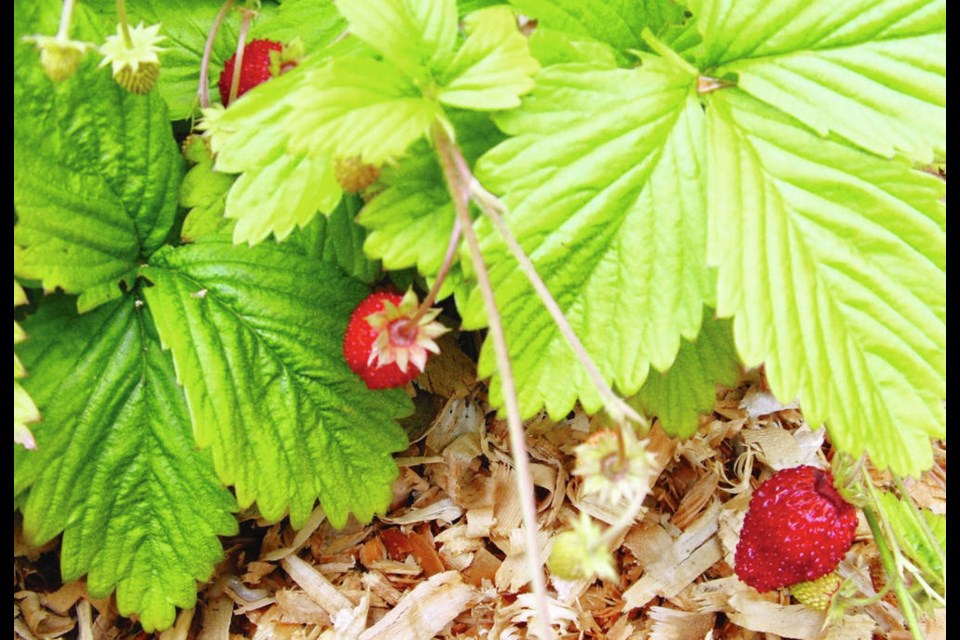Despite the relentless tedium of trying to keep plantings alive in the heat and drought, the garden has been delivering a delectable array of tasty snacks. Every trip into and out of the back garden has become a munch-fest featuring tiny alpine strawberries, blueberries, cherry tomatoes, juicy young beans, and golden purslane leaves loaded with lemony succulence. I even have a few Cape gooseberry plants this year. The little golden berries enclosed in papery coverings are a sweet treat.
Keeping a garden’s plantings looking fresh and perky in August always has been a challenge. This year, gardeners have been commenting that, because of the heat and drought, their gardens “looked like August” in July.
I’ve observed in my own garden that the usual watering routine is just not adequate this summer. The soil dries out too quickly. The lack of rain through the spring, no significant moisture-replenishing June rains, searing heat at the end of June and no rain since then have all contributed to the depletion of residual soil moisture — especially in light, sandy soils. It’s no wonder that previously adequate watering practices might not be sufficient now.
Then there are water shortages and rationing in parts of the Island an on nearby islands. Here are a few thoughts on using available water as effectively as possible.
* Plump the soil. Organic matter such as compost and composted manures added to the soil promotes a spongy, water-retentive texture while it also helps to keep a soil adequately aerated.
* Timing. Check for soil moisture before watering. Plunge a trowel or narrow-bladed shovel into the ground and lever it forward. Feel for moisture. For most well established plants it’s fine for the top five cm or so to dry as long as there is moist soil below.
Seed beds, young transplants and even recently transplanted perennials and shrubs need regular watering to keep the soil moist while root systems develop. Even drought tolerant and native plants need water for the first year or two while they establish strong roots.
To reduce water loss through evaporation, water early in the morning or in the evening.
* Long, slow, deep watering percolates most effectively into the soil. As I’ve been tidying garden beds, I’ve been lightly cultivating the soil to stir it up a little before watering. That too helps water to penetrate the soil easily.
* Mulch. After loosening the soil and watering, a layer of a nourishing compost will further help to enrich the soil and enhance moisture retention.
Russian tomatoes and Italian lettuce. Muriel has written from Chemainus with some observations on her food garden: “For 15 or 20 years my favourite tomato for growing in pots has been Silvery Fir, a determinate heritage tomato originally from Russia. I have four plants growing in a 50-cm wide, 30-cm deep pot.
“All the plants are covered with tomatoes. They suffered in the heat wave, but I kept them well watered and the tomatoes are developing just fine. The container planting would probably be happier with only three plants, but I had one left over and could not resist adding it to the group. The seeds were from Salt Spring Seeds.
“Also from Salt Spring Seeds was my newest discovery, a semi-heading lettuce called Drunken Woman, described in some places as ‘frizzy headed.’ It survived the heat in slightly shaded areas, and produced well. It’s a good ‘cut and come again’ lettuce.”
I’ve noted Muriel’s experience with Drunken Woman and am planning to try it again next year. The Salt Spring Seeds online catalogue has an enticing photo of this lettuce. They identify it as an Italian heirloom that forms large, loose heads of crinkled green leaves with ruffled, bright red edges. Drunken Woman is “crisp, sweet, and very slow to bolt.”
I’ve grown Silvery Fir, but in wire tomato cages in the open garden. I remember the fine, almost carrot-like foliage. It’s another heirloom variety. Salt Spring Seeds describes the plants as growing 60 to 90 cm tall and producing tomatoes with tender skins and a strong, lingering, “superb” flavour. They recommend it for growing in containers. I had not thought of adding it to my pool of potted patio tomatoes. Next year. Thank you, Muriel.



